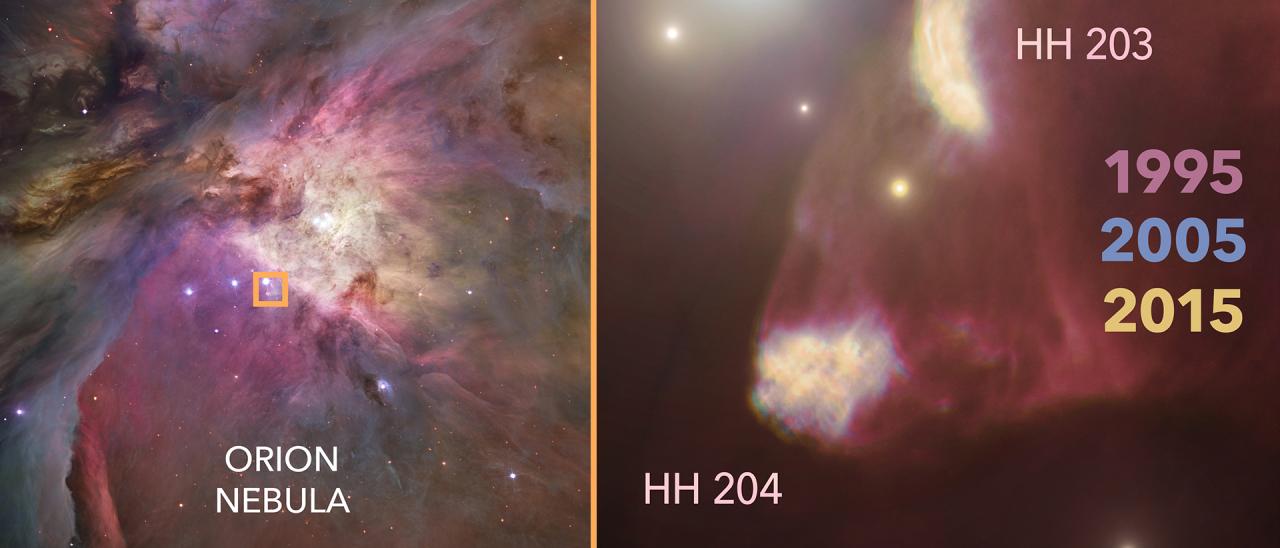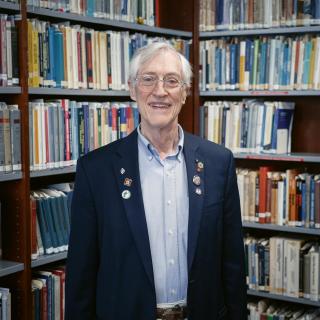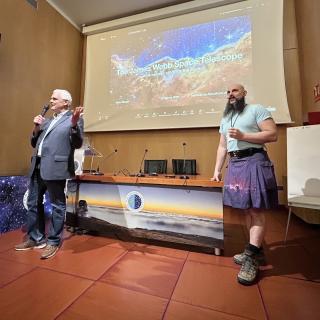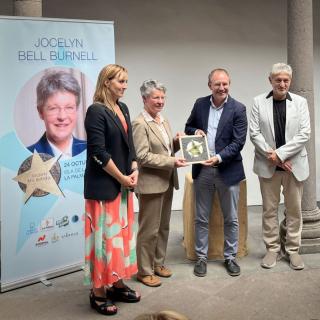An international team led by researchers from the Instituto de Astrofísica de Canarias (IAC) has uncovered, with an new high degree of detail, the physical and chemical effects of the impact of a protostellar jet in the interior of the Orion Nebula. The study was made using observations with the Very Large Telescope (VLT) and 20 years of images with the Hubble Space Telescope (HST). The observations show evidence of compression and heating produced by the shock front, and the destruction of dust grains, which cause a dramatic increase in the gas phase abundance of the atoms of iron, nickel, and other heavy elements in the Orion Nebula. The results were recently published in The Astrophysical Journal.
The Orion Nebula, one of the known and brightest objects in the night sky, is the nearest region of massive star formation to Earth, and it has a complex and extensive gas structure. Some of the newborn stars within it emit jets of gas at high speed which, when they impact their surroudings, produce shock fronts which compress and heat the nebular gas. These impact zones are bow-shaped, and are called Herbig-Haro objects, after their discoverers, the US astonomer George Herbig, and the Mexican astronomer Guillermo Haro.
These objects have been observed previously in many dark nebulae, where the cold gas is neutral, and its main source of energy is the heat generated by the shock. However, the jets of gas in the Orion Nebula are immersed in a large radiation field produced by the most massive stars in the Trapezium of Orion, situated at the centre of the nebula. Due to this radiation the gas within the shock front and also the gas compressed after it has passed through, is warm and ionized, and this allows us to measure precisely the physical conditions and the chemical composition of the jet.
The research carried out by a team of astronomers in Spain, Mexico and the United States, led by José Eduardo Méndez Delgado, a doctoral student at the IAC and the University of La Laguna (ULL), has uncovered the complex relations between the ionic abundances of the gas and its physical conditions in HH204, one of the most prominent Herbig-Haro objects in the Orion Nebula.
“Our work shows that the in the shock front of HH204 the gas abundances of heavy elements such as iron and nickel are increased by up to 350% compared to the values usually found in the Orion Nebula, and this allows us to determine the proportion of other chemical elements more accurately, which contributes to an improved knowledge of the chemical evolution in the solar neighbourhood”, explains José Eduardo Méndez Delgado, the first author of the article.
“As well as the heavy element enrichment in the gas phase, we have observed a heated post-shock zone which comprises a very small fraction of the gas, and which lets us understand the different layers of the structure of the Herbig-Haro object generated by the impact of the shock front”, says César Esteban, and IAC researcher and a co-author of the article.
“The origin of HH204 appears to be associated with one of the most brilliant and star formation rich zones of the Orion Nebula, the regions called Orion South, although there are many interactions of gas which appear to feed it from several directions”, adds William Henney, a researcher at the Institute of Radioastronomy and Astrophysics at the National Autonomous University of Mexico, and a co-author of the article.
“Thanks to the images of the Hubble Space Telescope we have shown that HH204 is propagating at an angle of 32º with the plane of the sky, which lets us observe the compression of the gas transversely as we approach the shock front”, points out Karla Arellano Córdova, a researcher at the University of Texas at Austin, and a co-author of the article.
“We have seen that the impact of these objects can be important when determining the local physical conditions in ionized nebulae. In fact, if we don’t take these effects into account we can make incorrect determinations of the chemical composition of the ionized nebulae, which are fundamental techniques for understanding the chemical evolution of the Universe”, sums up Jorge García Rojas, an IAC researcher and a co-author of the article.
Article: Méndez-Delgado, J. E.; Henney, W. J.; Esteban, C.; García-Rojas, J.; Mesa-Delgado, A. & Arellano-Córdova, K. Z. “Photoionized Herbig-Haro objects in the Orion Nebula through deep high-spectral resolution spectroscopy II: HH204”. The Astrophysical Journal. DOI: https://iopscience.iop.org/article/10.3847/1538-4357/ac0cf5#artAbst
- Arxiv: https://arxiv.org/abs/2106.08667
Contact at the IAC:
- José Eduardo Méndez Delgado: jemd [at] iac.es (jemd[at]iac[dot]es)
- César Esteban: cel [at] iac.es (cel[at]iac[dot]es)
- Jorge García Rojas: jogarcia [at] iac.es (jogarcia[at]iac[dot]es)
Photo caption:
View of HH204, a Herbig-Haro object in the Orion Nebula. The left panel shows the Orion Nebula observed with the Hubble Space Telescope, picking out the area around HH204. In the right panel, we can see in detail the structure of HH204 and of its apparent companion, HH203. In this panel, the images by the Hubble Space Telescope taken during 20 years and artificially highlighted with different colours show the advance of the jets of gas through the Orion Nebula. Credit: Gabriel Pérez Díaz, SMM (IAC).




